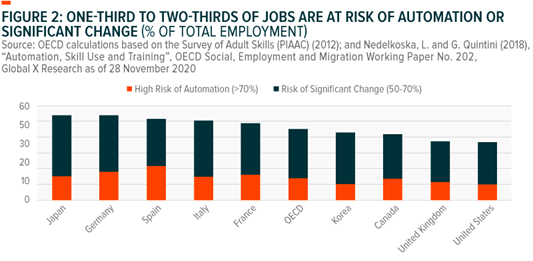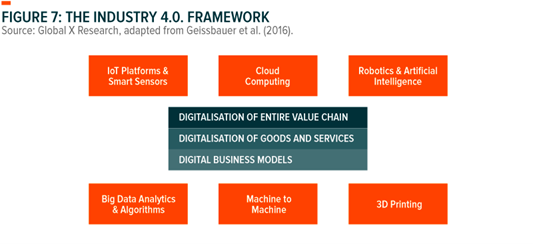The digital revolution started in the 1980s with the start of the Internet which provided computers with the needed path to connect. Connectivity drove the digitalisation of numerous industries, like manufacturing, banking, healthcare, and entertainment. Most recently, the global COVID-19 pandemic quickened the adoption of some disruptive technologies as businesses and individuals adapted to stay-at-home orders.
Defining the digital economy
While there is no consensus of what encompasses the Digital Economy, it generally refers to all economic activity reliant or enhanced by digital inputs (i.e. Information and Communication Technology (ICT), digital infrastructure, products, services, and data)1. Measuring the size of the digital economy as well as the extent to which it contributes to overall economic growth is challenging since digital inputs are incorporated throughout the global value chain.
Overall, the digitalised economy generated almost half of value-added and half of the new employment in G20 economies between 2006 and 2017, according to OECD’s estimates. Its size is smaller in developing nations where it represents approximately a quarter of total employment. The digital transformation is expected to increase productivity over the long term, lower prices, boost demand for new innovative products and ultimately create jobs in digitalised sectors. In contrast, sectors of low digital intensity may experience job destructions because of automation.

The race to global dominance in the digital economy
The adoption of digital technologies is heterogenic across industries and countries, with rising disparities in terms of digital infrastructures, skills, regulations, and social preferences, and resulting in a fragmented Digital Economy. Most technology companies are in the US and Asia while Europe captures only 10% of global funding for its start-ups5. Technology has been a rising source of geopolitical tensions within western countries and between the US and China in the past few years. In response, international cooperation on digital technologies are emerging among western nations. Joe Biden’s victory in the US presidential election revived talks around a transatlantic agenda between the US and the EU which encompasses policy proposals of the digital environment, including common approaches to antitrust enforcement and cybersecurity6. This agenda underlines the determination of the EU and US to shape the digital regulatory environment.
The digital transformation of business models, moving towards Industry 4.0
Digital innovations are transforming the entire ecosystem. New business models emerge across all services from entertainment to finance with subscription models (e.g. Netflix), free models (e.g. Instagram, Facebook, etc), on-demand models (e.g. Uber), or sharing models (e.g. AirBnB) to name a few. Similarly, technology companies are transforming the traditional manufacturing business model by incorporating data analytics to hardware, leading to the emergence of IoT business models like predictive maintenance and outcome-based business models selling and pricing performance instead of hardware9. The hardware-focused business model in manufacturing is shifting towards a broader business model including hardware, software and services, blurring the line between traditional sectors.

Capturing the potential of the digital economy
The disruptive nature of the digitalised economy challenges traditional investment frameworks. Conventional portfolio construction is often structured around managing traditional sector allocations relative to a benchmark to generate excess returns or reduce risks. Traditional sectors, however, are already well-established segments of the economy and tilt heavily towards the companies that have been historically successful. Conversely, companies leading in disruptive themes, like those that implement the IoT to enhance the manufacturing process, are often smaller in nature and can range across different sectors and geographies. Accurately capturing these firms, therefore, requires a forward-looking investment approach that extends beyond the traditional sector frameworks to identify the fast-growing trends of the next decade.
Thematic investing is an investment approach that involves in-depth research to identify the disruptive trends that will drive value creation in the future, and the companies best positioned to benefit from the materialisation of these trends. Thematic ETFs can help investors gain targeted exposure to these disruptive themes in a single investment. They use a systematic investment process to assemble baskets of securities that provide distinctive and diversified exposure to disruptive themes. In order to accurately target these disruptions, thematic ETFs should only include specialist companies that have the most to gain from the emergence of these themes. One way of constructing a pure-play portfolio is to select companies having most of their revenues generated by activities directly linked to the targeted disruptive theme. Therefore, thematic investing is a growth-oriented strategy that not only has the potential to outperform over the long term but also constitute unique building blocks to prepare global equity portfolios for an increasingly digitalised world.
Morgane Delledonne is director of research at Global X
Definition of the Digital Economy by the G20 group.
The OECD’s task force on ‘Measuring GDP in a Digitalised Economy’ was established in 2017.
To create its new digital economy estimates, the Bureau of Economic Analysis uses a supply-use framework including the ICT sectors, e-commerce, and priced digital service.
Gordon Moore (co-founder of Intel) observed that the number of transistors in a dense integrated circuit doubles about every two years leading to an exponential growth in computing power and subsequently reducing the costs of production of computers.
Statista estimate (Digital Economic Outlook 2020)
The Financial Times reported on 30 November 2020 that a draft policy proposal, entitled “a new EU-US agenda for global change”, will be
Cyber-physical production systems are ‘systems of collaborating computational entities which are in intensive connection with the surrounding physical world and its on-going processes, providing and using, at the same time, data-accessing and data-processing services available on the internet’. László Monostori, Cyber-physical Production Systems: Roots, Expectations and R&D.
Deloitte (2014) Industry 4.0 Challenges and solutions for the digital transformation and use of exponential technologies.
IoT business models where the contract guarantees machine performance, according to McKinsey.



